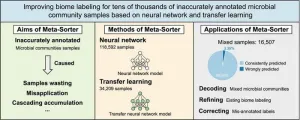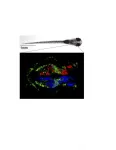(Press-News.org) PHILADELPHIA— The blood-brain barrier (BBB) has been found to play a significant role in controlling behavior critical to how ant colonies function, according to new research from the Perelman School of Medicine at the University of Pennsylvania. The implications of this research on the intricate mechanisms behind ant behavior go beyond the world of ants. The findings, published this week in Cell, hint at similar mechanisms at play in other species, including mammals.
In ants, along with other animals, the BBB consists of tightly locked cells that protect the brain from germs and other harmful substances. The protective barrier plays a key role in how the brain and nervous system operate. The research, led by Shelley Berger, PhD, the Daniel S. Och University Professor and director of the Penn Epigenetics Institute, and her lab, focused on Carpenter ants and their unique caste-based behaviors. These different castes (social groups) within an ant colony often perform different tasks within the colony, and also often display drastic differences in lifespan.
In these ants, the BBB produces a specialized version of the enzyme Juvenile hormone esterase (Jhe), responsible for breaking down the Juvenile Hormone (JH3)—which regulates development and reproduction maturation. This Jhe enzyme is typically then deposited in the blood of the insect. However, the researchers found the Jhe enzyme produced by the BBB of carpenter ants is retained within the BBB cells. This localized enzyme controls the amount of JH3 that enters the brain of worker ants.
Different types of worker ants within the same colony have different responsibilities—such as gathering food, building tunnels, or defending the colony. The new findings show that this results, in part, from different levels of the JH3 enzyme expression in their BBB, leading to different levels of the hormone JH3 in the brain. These differences drive the diverse behaviors exhibited by different worker ants within the same colony, including foraging and defense.
“This research reveals a remarkable link between a single enzyme and complex social behaviors in ants,” said Berger. “A single enzyme can trigger a shift between distinct worker behaviors crucial for the colony's function. The blood-brain barrier's role in controlling these behaviors is truly remarkable and has implications beyond the ant world.”
The research began with single-cell RNA sequencing of different ant castes' brains—foragers and soldiers. This then revealed the distinct expression of the Jhe gene within the BBB cells. This finding, coupled with caste-specific differences, sparked the researchers' curiosity to unravel the broader implications of this mechanism in ant behavior.
“One surprising aspect of the study was the observation that manipulating Jhe levels in soldier ants led to a shift in behavior towards foraging,” said co-lead author Karl Glastad, PhD, a research associate in the Berger Lab. “This suggests that a single gene, encoding the Jhe enzyme, can substantially influence foraging behavior—a fundamental aspect of ant colony structure.”
The researchers also found that in Drosophila fruit flies the Jhe enzyme is naturally outside of cells. When they made the fly BBB express the ant version of the Jhe enzyme, they saw behavioral changes similar to those observed in the ants.
To see if similar mechanisms apply in other animals, the researchers also analyzed published data from a panel of mouse cells. The study's analysis of mouse endothelial cells suggests that BBB-controlled hormone entry into the brain might be a widespread phenomenon in the animal kingdom.
“This study showcases the power of modern biology techniques, such as single-cell sequencing, in uncovering hidden regulatory pathways,” said co-lead author Linyang Ju, a PhD candidate in the Berger Lab.
The researchers believe that this breakthrough could pave the way for understanding behavioral control in diverse organisms. Berger and her team are now focused on understanding the prevalence of this mechanism in other ant species and exploring its potential implications for behavior regulation in non-insect species.
###Penn Medicine is one of the world’s leading academic medical centers, dedicated to the related missions of medical education, biomedical research, excellence in patient care, and community service. The organization consists of the University of Pennsylvania Health System and Penn’s Raymond and Ruth Perelman School of Medicine, founded in 1765 as the nation’s first medical school.
The Perelman School of Medicine is consistently among the nation's top recipients of funding from the National Institutes of Health, with $550 million awarded in the 2022 fiscal year. Home to a proud history of “firsts” in medicine, Penn Medicine teams have pioneered discoveries and innovations that have shaped modern medicine, including recent breakthroughs such as CAR T cell therapy for cancer and the mRNA technology used in COVID-19 vaccines.
The University of Pennsylvania Health System’s patient care facilities stretch from the Susquehanna River in Pennsylvania to the New Jersey shore. These include the Hospital of the University of Pennsylvania, Penn Presbyterian Medical Center, Chester County Hospital, Lancaster General Health, Penn Medicine Princeton Health, and Pennsylvania Hospital—the nation’s first hospital, founded in 1751. Additional facilities and enterprises include Good Shepherd Penn Partners, Penn Medicine at Home, Lancaster Behavioral Health Hospital, and Princeton House Behavioral Health, among others.
Penn Medicine is an $11.1 billion enterprise powered by more than 49,000 talented faculty and staff.
END
Penn Medicine research uncovers brain-blood barrier's role in governing ant behavior
Researchers shed light on the hidden influence of a single enzyme on ant behavior
2023-09-08
ELSE PRESS RELEASES FROM THIS DATE:
Using smart bioelectronic devices to capture and release tumor cells
2023-09-08
Metastasis is the leading cause of death in cancer, occurring when a cell leaves the primary tumour, passes into the bloodstream and lymphatic system and reaches distant organs. Non-invasive collection of these circulating tumour cells is essential for the study of cell biology, the diagnosis and prognosis in cancer research, and drug development. As a general rule, the concentration of cancer cells found in blood is very small with respect to other cell types, and traditional methods of collecting them in a viable way are laborious.
“We wanted to come up with a device capable ...
Obstetrics & Gynecology devotes special issue to addressing racism in reproductive health
2023-09-08
September 8, 2023 — As part of its active efforts to dismantle systemic racism and promote principles of equity and inclusion within its editorial processes and content, Obstetrics & Gynecology, the official journal of the American College of Obstetricians and Gynecologists, has devoted its entire October 2023 issue to addressing racism in reproductive health. The journal is published in the Lippincott portfolio by Wolters Kluwer.
A journal with such a rich history must root out inequity
"Let ...
Valleytronics is warming up at Brookhaven Lab
2023-09-08
UPTON, NY—Researchers at the Center for Functional Nanomaterials (CFN), a U.S. Department of Energy (DOE) Office of Science User Facility at DOE’s Brookhaven National Laboratory, and Northrop Grumman, a multinational aerospace and defense technology company, have found a way to maintain valley polarization at room temperature using novel materials and techniques. This discovery could lead to devices that store and process information in novel ways using this technology without the need to keep them at ultra-low temperatures. Their ...
Refining biome labeling for microbial community samples: AI approach unravels hidden
2023-09-08
In a groundbreaking study published on July 26, 2023, in the journal Environmental Science and Ecotechnology, researchers from Huazhong University of Science and Technology have introduced "Meta-Sorter," an AI-based method that leverages neural networks and transfer learning to significantly improve biome labeling for thousands of microbiome samples in the MGnify database, especially those with incomplete information. The Meta-Sorter approach comprises two crucial steps. Firstly, a neural network model is meticulously constructed using 118,592 microbial samples from 134 biomes and their respective biome ontology, boasting an impressive average ...
Exercise-induced hormone irisin may reduce Alzheimer’s disease plaque and tangle pathology in the brain
2023-09-08
BOSTON – Researchers who previously developed the first 3D human cell culture models of Alzheimer’s disease (AD) that displays two major hallmarks of the condition—the generation of amyloid beta deposits followed by tau tangles—have now used their model to investigate whether the exercise-induced muscle hormone irisin affects amyloid beta pathology.
As reported in the journal Neuron, the Massachusetts General Hospital (MGH)–led team has uncovered promising results suggesting that irisin-based ...
Immunogenicity and reactogenicity of co-administration of COVID-19 and influenza vaccines
2023-09-08
About The Study: In this study of health care workers who received a COVID-19 vaccine, an influenza vaccine, or both, co-administration was not associated with substantially inferior immune response or to more frequent adverse events compared with COVID-19 vaccine administration alone, supporting the co-administration of these vaccines.
Authors: Gili Regev-Yochay, M.D., of the Sheba Medical Center in Ramat Gan, Israel, is the corresponding author.
To access the embargoed study: Visit our For The Media website at this link https://media.jamanetwork.com/
(doi:10.1001/jamanetworkopen.2023.32813)
Editor’s ...
Readmission rates after acute respiratory distress syndrome in children
2023-09-08
About The Study: The findings of this study suggest that childhood survivors of acute respiratory distress syndrome (ARDS) are at high risk of readmission in the first two months after discharge. Future studies should evaluate whether post-discharge interventions (e.g., telephonic contact, follow-up clinics, and home health care) may help reduce the readmission burden.
Authors: Garrett Keim, M.D., of Children’s Hospital of Philadelphia, is the corresponding author.
To access the embargoed study: Visit our For The Media website at this link https://media.jamanetwork.com/
(doi:10.1001/jamanetworkopen.2023.30774)
Editor’s ...
Ballet of the brain: Unlocking the choreography of movement
2023-09-08
The zebrafish brain, though simpler than its human counterpart, is a complex network of neurons that engage in a ceaseless dance of electrical activity. What if this neural ballet could reveal the secrets of how brains, including our own, control movement? A zebrafish study led by researchers at the Champalimaud Foundation offers a new lens through which to view the activity of neural populations, and to understand how the brain orchestrates motion.
Why we have a brain
“The brain’s primary function is movement”, explains Claudia Feierstein, lead author of the study ...
Bacteria generate electricity from wastewater
2023-09-08
“We engineered E. coli bacteria, the most widely studied microbe, to generate electricity,” says Professor Ardemis Boghossian at EPFL. “Though there are exotic microbes that naturally produce electricity, they can only do so in the presence of specific chemicals. E. coli can grow on a wide range of sources, which allowed us to produce electricity in a wide range of environments, including from waste water.”
In a paper published in the journal Joule, Boghossian’s team report a groundbreaking achievement in bioelectronics, advancing the capabilities of common E. coli bacteria to generate ...
Probing the unimaginable: New data help to understand the nature of aphantasia
2023-09-08
The ability to visualize faces, objects, landscapes, or even scenes from the past exists on a spectrum. While some can picture the layout of a city in minute detail and mentally walk through it, street by street, others have a perfectly blank internal cinema. In this case, we speak of aphantasia—the inability to voluntarily produce the visual mental image corresponding to an idea.
People whose aphantasia is congenital—i.e., not due to a stroke, brain injury, or psychiatric illness—become aware of their peculiarity reasonably ...
LAST 30 PRESS RELEASES:
Injectable breast ‘implant’ offers alternative to traditional surgeries
Neuroscientists devise formulas to measure multilingualism
New prostate cancer trial seeks to reduce toxicity without sacrificing efficacy
Geometry shapes life
A CRISPR screen reveals many previously unrecognized genes required for brain development and a new neurodevelopmental disorder
Hot flush treatment has anti-breast cancer activity, study finds
Securing AI systems against growing cybersecurity threats
Longest observation of an active solar region
Why nail-biting, procrastination and other self-sabotaging behaviors are rooted in survival instincts
Regional variations in mechanical properties of porcine leptomeninges
Artificial empathy in therapy and healthcare: advancements in interpersonal interaction technologies
Why some brains switch gears more efficiently than others
UVA’s Jundong Li wins ICDM’S 2025 Tao Li Award for data mining, machine learning
UVA’s low-power, high-performance computer power player Mircea Stan earns National Academy of Inventors fellowship
Not playing by the rules: USU researcher explores filamentous algae dynamics in rivers
Do our body clocks influence our risk of dementia?
Anthropologists offer new evidence of bipedalism in long-debated fossil discovery
Safer receipt paper from wood
Dosage-sensitive genes suggest no whole-genome duplications in ancestral angiosperm
First ancient human herpesvirus genomes document their deep history with humans
Why Some Bacteria Survive Antibiotics and How to Stop Them - New study reveals that bacteria can survive antibiotic treatment through two fundamentally different “shutdown modes”
UCLA study links scar healing to dangerous placenta condition
CHANGE-seq-BE finds off-target changes in the genome from base editors
The Journal of Nuclear Medicine Ahead-of-Print Tip Sheet: January 2, 2026
Delayed or absent first dose of measles, mumps, and rubella vaccination
Trends in US preterm birth rates by household income and race and ethnicity
Study identifies potential biomarker linked to progression and brain inflammation in multiple sclerosis
Many mothers in Norway do not show up for postnatal check-ups
Researchers want to find out why quick clay is so unstable
Superradiant spins show teamwork at the quantum scale
[Press-News.org] Penn Medicine research uncovers brain-blood barrier's role in governing ant behaviorResearchers shed light on the hidden influence of a single enzyme on ant behavior




